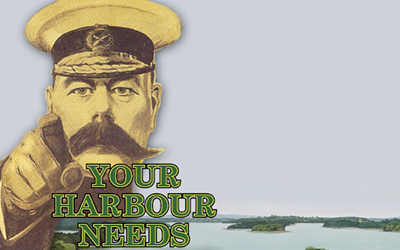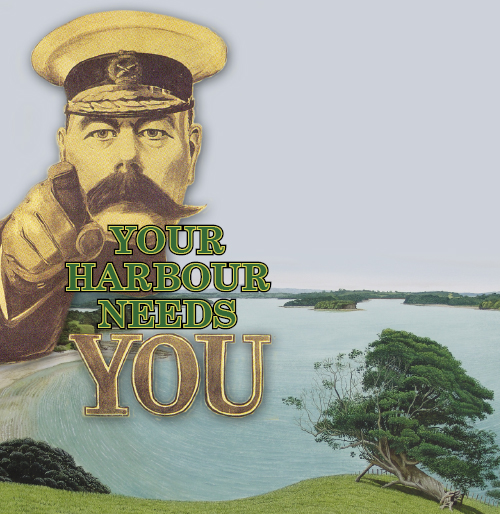Methods of building membership in the digital age


Knocking the Stuffing Out: While going paperless dispensed with the time-and-planet-consuming process, not to mention expense, of stuffing envelopes, it simultaneously knocked the stuffing out of Mahurangi Action’s financial membership. artists foreground Alfred Leete background Philip Kilmore
It took the stuffing of thousands of envelops, and the licking of a like number of stamps.
That, and the not inconsiderable matter of the publishing and launching of Jade River : A History of the Mahurangi, and the membership of Mahurangi Action built to 300.
From there it has since declined to a sixth of its ephemeral 2001 peak, partly due to the largely paperless operation of the society since 2007, when the online Mahurangi Magazine succeeded the one glossy magazine format publication that was the pinnacle of a succession of an increasingly sophisticated and costly (particularly to the environment) series of Mahurangi Bulletins.
It is small wonder that a number of organisations that know better persist is printing and mailing promotional material to existing and potential members: it works—a paper invoice must be deliberately and physically binned if it is to be ignored, whereas the digital equivalent, even if not summarily dragged to the trashcan icon, is soon deeply buried in relentlessly filling inboxes.
But Mahurangi Action is not about to go back on its commitment to behave green as well as be green, unlike Greenpeace or the Green Party. There are smart ways in which people can be encouraged to respond, digitally or by mail, that societies such as Mahurangi Action can adopt. One such is to simply provide previous or potential members with motivating information, such as this fact: Since Mahurangi Action emailed 28 invoices on 28 October, 27 mostly existing members have become financial, with 10 electing to pay the regatta-supporter rate of $50, rather than the regular rate of $10. It appears that we are more likely to stump up when we hear our peers are also doing.
Individual invoices also help, which is partly the reason for this article. The Mahurangi Magazine has a hard-won mailing list currently numbering 316, nearly eight times larger than Mahurangi Action’s membership list. Although it would be a bit cheeky, if Mahurangi Action was to invoice those 276 readers, a goodly number would respond, particularly if there knew a good number of other Mahurangi Magazine readers were doing likewise. And although it would be beyond cheeky, if Mahurangi Action’s secretary was to email individualised invoices to his precisely 1400 contacts not financial members, it is possible that membership would be restored to immediately-post-Jade River levels within the week. There is, however, an ethical alternative to sending out unsolicited invoices: make it easy for readers to request one.
Ex sports-car-spare-parts-manufacturer-turned-farmer Mike Neil, who served on the committee in that period, always argued that Mahurangi’s environmental protection organisation, if it was to convincingly represent the harbour before the likes of the local council, needed establish a membership of at least 500. With local now being regional, the successful international exporter’s argument is even stronger, particularly when fronting a proposal as regionally and nationally important as the Te-Araroa-linking Mahurangi Coastal Trail. Which brings in another proven technique: linking an appeal, in this case to membership, to something dear to a prospect’s heart. For this reason, Mahurangi Action is extending member Shane Hartley’s successful suggestion of a regatta-supporter rate, to promotion of the Mahurangi Coastal Trail, with $40 of the $50 going into a dedicated account to further that project. Then, as an additional inducement to subscribing at a supporter rate, the annual field-day bus trip, and return trip up the Mahurangi River aboard the Jane Gifford, would be free, with others paying slightly more, say $55 per head.
There is much the committee can and must do if the organisation is to justify its claim to represent the Mahurangi, given the enormous number of enthusiasts the river and harbour enjoys—the Mahurangi Magazine was visited by 120 000 people in the last 12 months, and hit (a possibly meaningless measurement) more than 13 million times. The simplest way, however, is still the most powerful: word of mouth—if each member, on average, convinces one other person to subscribe, or even to consent to being added to the Mahurangi Magazine’s mailing list…
The challenge is to ever-so-slightly close the gap between 13 million hits and a few dozen financial members.
